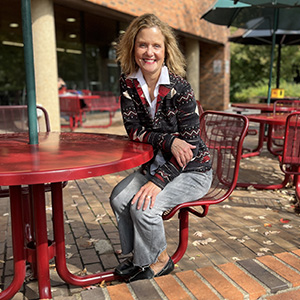In the new Human Centered Design Foundations course—a partnership between CCAPS and the Minnesota Design Center—learners will gain an understanding of how to creatively work through complex problems they may be facing in their communities
“Humans have been designing throughout our history. It’s why we are able to survive,” says Tom Fisher, director of the U of M's Minnesota Design Center and the Dayton Hudson Chair in Urban Design in the College of Design. “We’re not very strong. We’re not very fast. But we’re able to adapt to new situations and be creative and innovative when encountering challenges. And so design has really been one of the survival strategies for humans, it’s as old as humanity itself.”
Starting in March, learners of all ages will have the opportunity to hone their skills designing the services offered by their organizations in Human Centered Design Foundations. Ryan Torma from the U’s College of Continuing and Professional Development (CCAPS) explains: “We wanted to offer this course so that professionals can learn these great human-centered design techniques and practices for working through complex problems on their own and not just with trained designers.”
So … what is human-centered design?
According to Fisher, it’s about making people’s lives better. The distinction Fisher draws, though, is that human-centered design isn’t just focused on goods or products.
“When we think of design, we usually think of houses, clothing, cars, computers,” he says. “However, in recent decades, we’ve had this idea of designing services and systems. I think the service economy is almost four times the size of the goods economy, yet a lot of our services are really badly designed. There’s a lot of dysfunction, a lot of inefficiency. At the same time, we’re seeing all these larger global challenges that come from poorly designed systems, such as transportation, which is dependent on fossil fuels, or an energy system that’s dependent upon natural gas and coal. And these things are having deleterious effects on the planet as well as on people. So we’re basically using the same methods that we would use in designing things but we’re designing systems and services to make them better.”
Fisher explains that another way human-centered design is different from how we usually think about design is that the expert model is flipped to favor an approach that involves the people who are affected by or use the system or service. “We’re going to learn from everybody, in terms of what the issues are and what their ideas might be. It’s more of a process of helping everybody be creative co-designers in the development of better solutions. So it’s really about empowering ordinary people.”
A simple solution to a sticky problem
As an example, Fisher points to a famous case study involving a national health care company. They were experiencing a lot of prescription errors that caused many patients to get sick or worse, and they needed to get to the bottom of it. In talking with and observing nurses at work, they saw that nurses were constantly being interrupted, causing them to lose track of what they were doing. In a brainstorming group of nurses formed to find a solution, one was married to an airline pilot. She noted that, during takeoffs and landings, the door to the cockpit is locked so that pilots can’t be bothered during those moments when their singular focus on the job at hand is crucial. Extrapolating on that knowledge, the group came up with the idea of having nurses wear a yellow vest while filling prescriptions, and instituting a policy wherein nurses cannot be interrupted while they’re wearing the yellow vest.
“When the nurses were not interrupted, their errors went literally down to zero. And, you know, what’s really true is that a lot of the solutions are often very simple and really cheap. What I love about doing this work is that it’s not expensive and doesn’t lead to big, complicated things. If it’s done well, it frequently leads to really innovative but often quite cheap solutions to big, expensive problems,” says Fisher.
Seeking mission-driven people
“There are so many human-centered design trainings and programs available to the private sector," says Emily Stover, who will teach Human Centered Design Foundations and instructs the Interdisciplinary Design course for the College of Design. "We wanted to make something that was available to people who maybe are part of a nonprofit and can’t afford these really expensive boot camps.”
"We’re hoping to attract people in organizations that have more of a community-impact mission rather than those that are stakeholder-driven, or people who have a problem or a set of problems they are really passionate about being a part of fixing," she explains. "Maybe they’ve run into walls in the past, or are not quite sure how to work with other people to do that. This course will give them some tools to overcome those challenges."
Participants of the six-week course will meet for 90 minutes over Zoom, plus complete three to four hours of assignments or project work on their own per week. Course outcomes include framing critical design challenges from the user perspective, generating and testing design ideas through simple prototyping, and applying tools and methods for facilitating the design process.
“What I think they can come away from this course with is understanding some of those basics so they can go back and practice it at their job,” says Stover. “A second takeaway is to learn to really be expansive about the kinds of ideas they generate and then be really clear about how they will prototype and test them.”
Want to Learn More?
The first session of Human Centered Design Foundations begins March 13, 2024. For those interested in learning more about the topic in advance of the course, Stover will present a free webinar on January 31. Get more information on the webinar and register here.
Monique Dubos is a writer and content strategist with the U of M College of Continuing and Professionals Studies, where she has covered the College’s noncredit professional development, construction management, health services management, and IT infrastructure programs since 2018. She has also written for the Institute on the Environment, the Minnesota Technical Assistance Program, and various publications. Connect with her via LinkedIn.








